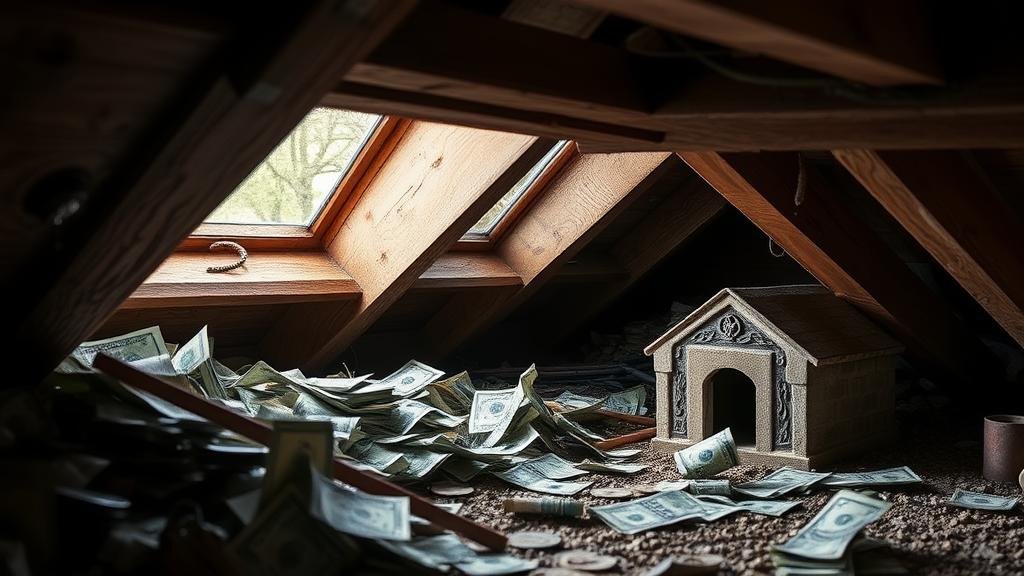Hunting for Forgotten Money Hidden in Attics and Crawl Spaces
Hunting for Forgotten Money Hidden in Attics and Crawl Spaces
Many homeowners may not realize that forgotten money can often be lurking in the most unexpected places within their homes. Attics and crawl spaces–typically known for storing memorabilia, old furniture, and winter clothes–can often hold unclaimed treasures, from rare collectibles to old coins. This article explores how to effectively hunt for these hidden monetary gems, illustrating the value, and providing actionable tips for thorough searches.
The Value of Forgotten Money
Why bother to search for forgotten money? The answer lies in tangible value. A study by the National Association of Realtors in 2021 estimated that the average American household possesses around $4,000 in cash and valuables that remain unclaimed or stashed away. In some cases, this can dramatically increase if collectibles, vintage items, or forgotten heirlooms are unearthed.
For example, uncirculated silver dollars from the late 1800s may fetch hundreds or even thousands of dollars in today’s market. Similarly, action figures from the 1980s and 1990s can become sought-after collectibles, sometimes being resold at prices well above their original retail value. e statistics underscore the potential financial benefits of searching the less frequented corners of our homes.
What to Look For
Understanding what types of items may be valuable can streamline your search. Below are categories of items to keep an eye out for during your hunt:
- Antique Furniture: Pieces can often escalate in value based on condition, rarity, and market demand.
- Collectibles: Items such as action figures, vintage toys, and memorabilia can be surprisingly valuable.
- Coins and Currency: Rare coins, paper money, and even foreign currency can accumulate value sharply over the years.
- Jewelry: Gold or silver jewelry, especially antique pieces, can yield significant worth.
- Art and Decor: Original artworks or even prints from renowned artists may hold speculative value.
Creating a Search Plan
A methodical approach enhances your chances of uncovering valuable items. Here’s a step-by-step plan for conducting an effective search:
- Prepare the Space: Start by ensuring that the areas you plan to explore are safe. Wear gloves, a mask, and suitable clothing to protect yourself from dust and allergens.
- Gather Tools: Equip yourself with a flashlight, boxes for organizing found items, a camera for documenting potential valuables, and a reference guide or smartphone app for identifying antiques.
- Focus on Areas of Interest: Begin with areas that are disorganized or appear neglected. Older boxes, old photo albums, and forgotten furniture can all hold hidden treasures.
Documenting Your Findings
As you sift through items, documenting your findings becomes critical. Take photos of each item and find comparable sales using online auction sites like eBay or specialized collectibles sites. This allows you to establish the market value for each item you discover.
For example, a rare comic book found in excellent condition may sell for both retail and auction estimates that can help in understanding the items worth. Comparison with other sales will also provide insights into demand, which is essential for determining whether to sell, hold, or appraise.
The Importance of an Appraisal
While self-assessment can offer preliminary insights, consulting an expert continues to be paramount for items you suspect to be high-value. Professional appraisers can provide authentication, proper valuation, and guidance for sale. According to the American Society of Appraisers, genuine artifacts require someone knowledgeable in the specific field of collectibles or antiques.
Potential Pitfalls
Assessing the rewards of your hunt also comes with potential challenges. False expectations can lead to disappointments. It’s crucial to approach this endeavor with realistic goals. Here are some common pitfalls to avoid:
- Stating False Value: Overestimating an items worth without research can lead to poor decision-making.
- Ignoring Condition: The state of an item plays a significant role in its value. Items with damages or wear may affect selling opportunities.
Conclusion: Actionable Takeaways
Hunting for forgotten money in attics and crawl spaces can be an exhilarating pursuit that combines both nostalgia and potential profit. Whether you are driven by the thrill of discovery or the financial gains, this process requires methodology, awareness of market trends, and a balanced view of your findings. Conduct thorough research, document your discoveries diligently, and consider seeking professional appraisal when needed.
By following these guidelines, homeowners and treasure hunters alike can possibly uncover forgotten fortunes that might otherwise remain hidden for a lifetime.



